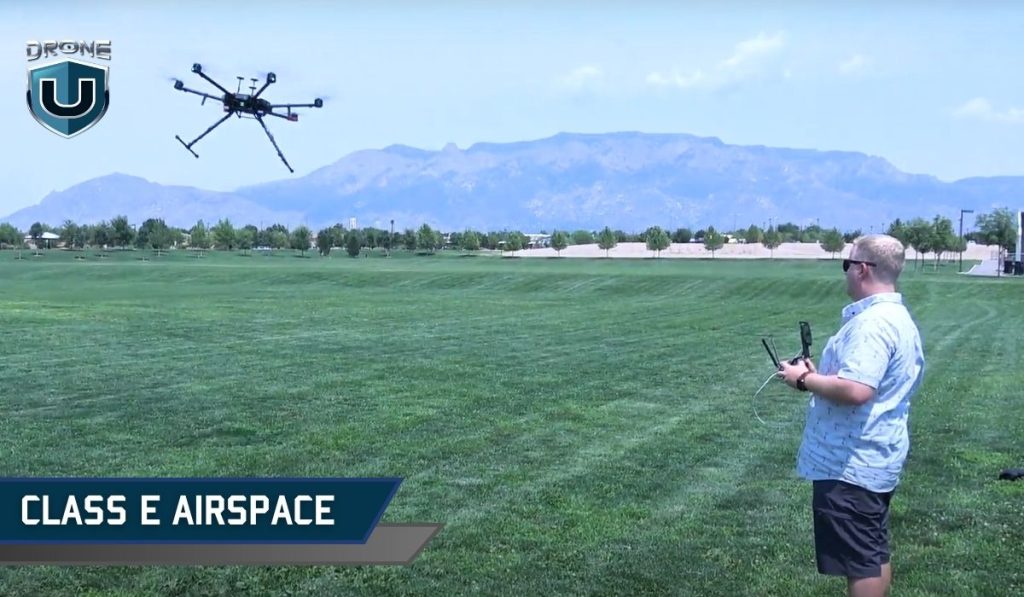
If you’re a drone pilot, chances are you’ve come across Class E airspace along the way. It’s one of those airspaces that can leave even experienced pilots scratching their heads.
Why?
Because Class E isn’t as cut-and-dry as other airspaces—its boundaries, visibility requirements, and even where it starts can vary depending on where you’re flying.
Confusing?
It certainly can be. But that’s exactly what this guide is here for.
In this article, we will dive deep into Class E Airspace—from its different types, visibility requirements, and where drone pilots can fly in this airspace.
Let’s start by understanding exactly what Class E airspace is.
What is Class E Airspace?
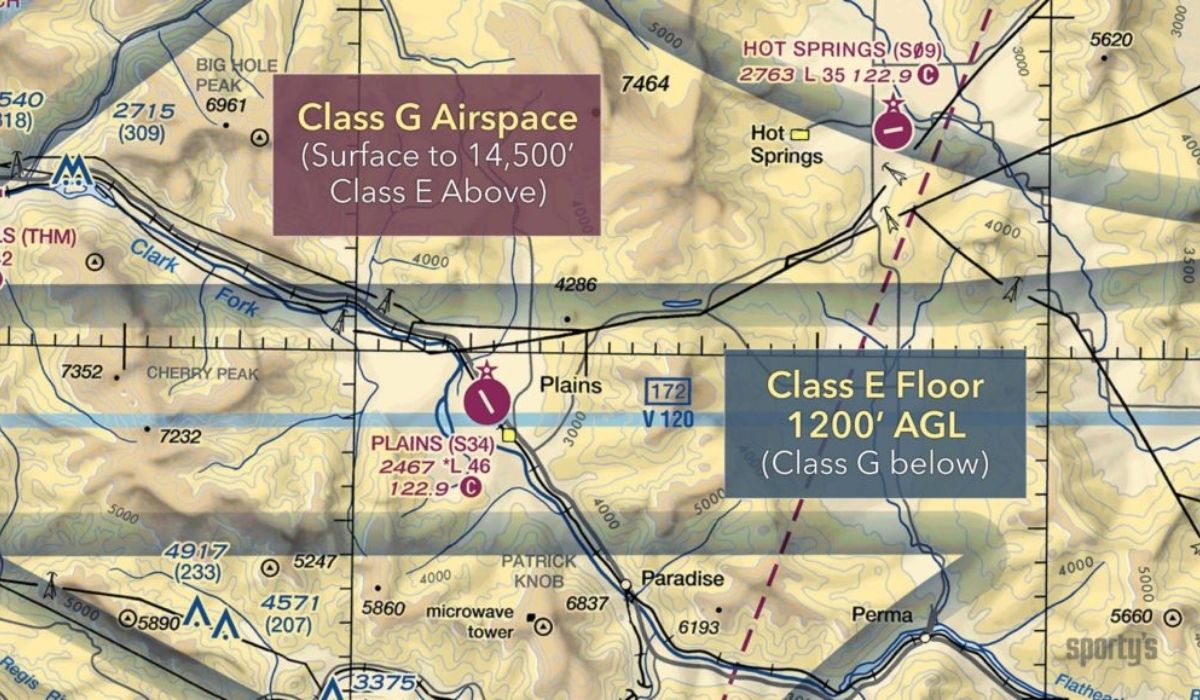
Class E airspace is one of the six FAA-designated controlled airspace categories. Sometimes informally called “Class Everywhere” pr “Class Eco” due to its widespread presence in the United States, Class E serves as a bridge between controlled and uncontrolled airspace.
While Class E may be less restrictive than Class A, B, C, or D airspace, it still maintains specific rules—particularly regarding weather requirements and ATC services. Understanding these rules is essential for safe and legal drone operations.
So, what are the key characteristics of this Class Eco airspace?
Let’s find out.
Understanding Class E Airspace Altitudes
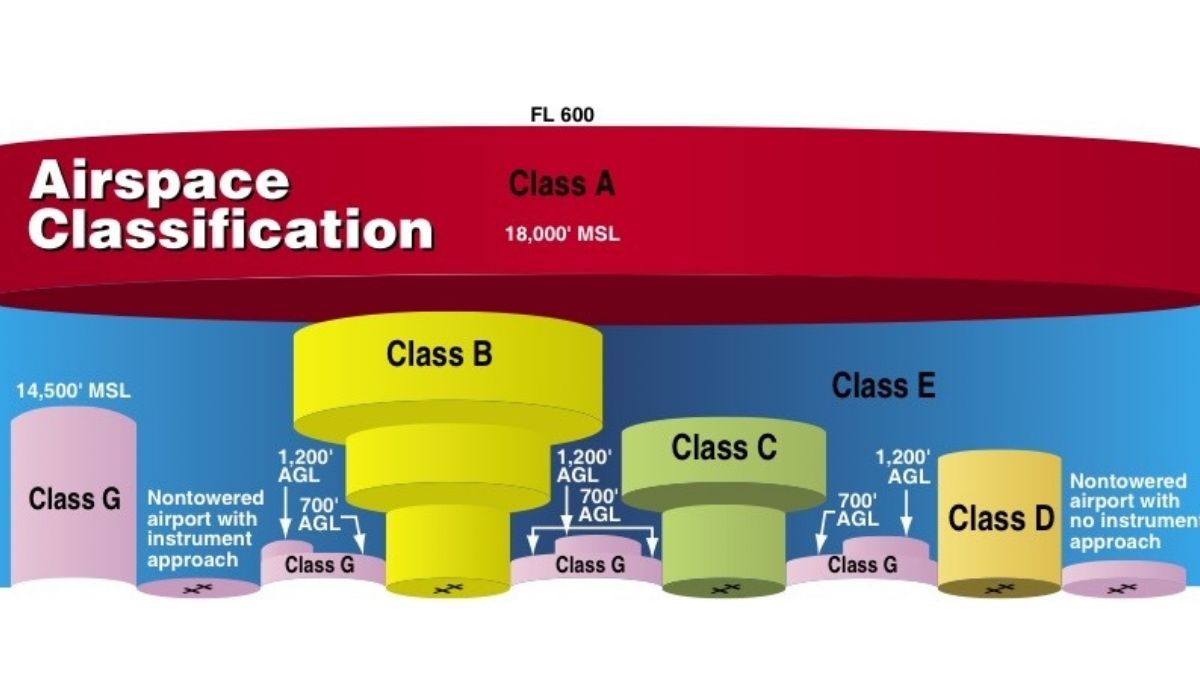
Class E airspace operates at different altitudes depending on its location and purpose.
In certain areas, there is also Class E airspace above Flight Level 600 (approximately 60,000 feet MSL).
Class E airspace operates at different altitudes depending on its use.
| Vertical Limits | Class E airspace can begin at various altitudes: at the surface, 700 feet AGL, or 1,200 feet AGL, depending on the location. It typically extends up to 18,000 feet MSL, where Class A airspace begins. |
| Horizontal Limits | Class E airspace can cover extensive areas, as it’s also referred to as “Class Everywhere.”
This means there are no set limits for Class E Airspace horizontal spread as it often depends on the flying conditions and its specific designations. |
Class E Airspace Types
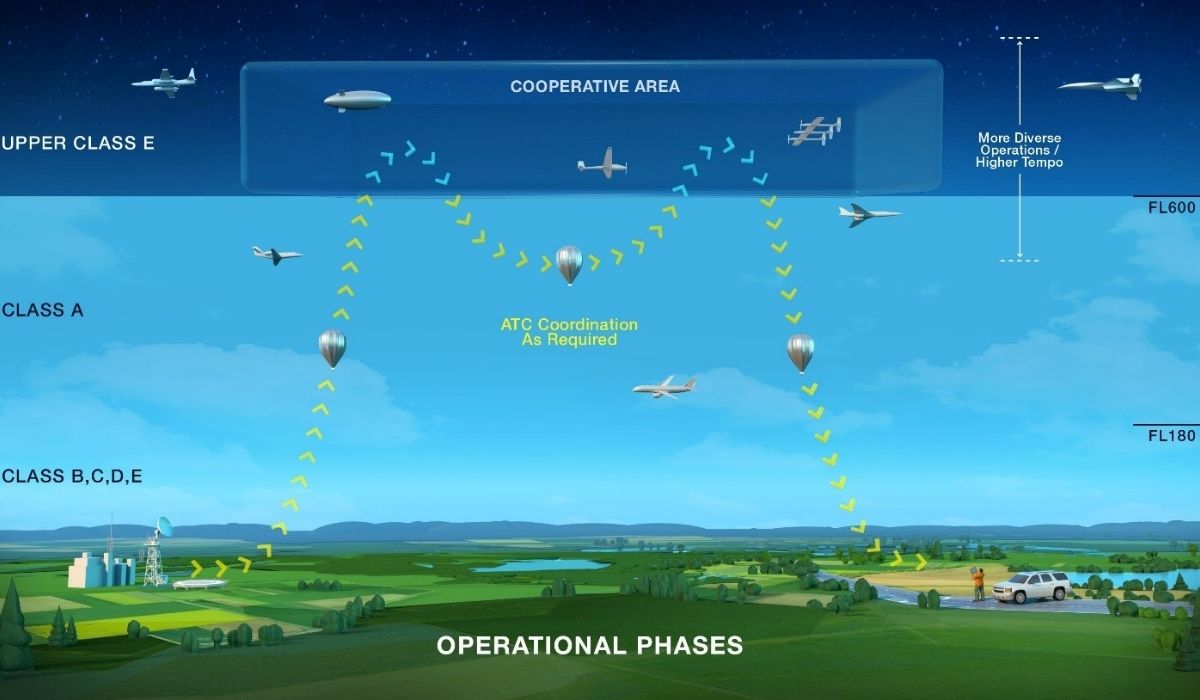
Before diving into the different types of Class E Airspace, let’s start with why this airspace exists in the first place.
Class E airspace was designed to manage and separate IFR (Instrument Flight Rules) and VFR (Visual Flight Rules) traffic. It allows Air Traffic Control (ATC) to guide and support you even when you are outside the controlled zones of Class A, B, C, and D airspace.
Let’s take a closer look at the different types of Class E Airspace:
1. Class E Surface Areas (E2)
This type of airspace usually begins from around airports without control towers.
These surface areas provide controlled airspace for ground up to safe takeoffs, landings, and maneuvering near airports.
2. Class E Transitional Areas (E3)
This type of airspace begins at 700 or 1,200 feet above ground level (AGL) and is positioned around airports. It typically allows transitioning between the airport and higher altitudes to stay within controlled airspace.
Flying drones in these areas sometimes requires additional caution and authorization.
3. Class E Extensions to a Surface Area (E4)
These controlled airspace extensions near class D or class C airspace facilitate safe arrivals and departures on a specific route.
Basically, extensions allow for controlled space in specific directions without growing Class D or C airspace.
4. Class E En route Airspace
En route airspace is designed to form safe travel corridors when flying at cruising altitudes.
This airspace stretches across the country alongside established airways and provides a safe zone when flying long distances.
5. High Altitude Class E (Above FL 600)
This airspace extends from Flight Level 600 (approximately 60,000 feet) and above. This controlled airspace is used for specialized operations including military testing and space operations, ensuring separation from commercial and general aviation traffic at lower altitudes.
Here’s a table summarizing the Class E Airspace types:
| Class E Airspace Type | Description | Purpose |
| Class E Surface Areas (E2) | Begins at ground level around airports without control towers. | Provides controlled airspace for safe takeoffs, landings, and maneuvering near airports. |
| Class E Transition Areas (E3) | Starts at 700 or 1,200 feet AGL around airports. | Allows aircraft to transition safely between the airport and higher altitudes. |
| Class E Extensions to a Surface Area (E4) | Extensions of Class D or C airspace | Facilitates controlled arrivals and departures along specific routes without expanding Class D or C boundaries. |
| Class E En route Airspace | Covers extensive corridors at cruising altitudes across the country. | Provides safe zones for long-distance flights along established airways. |
| High Altitude Class E (Above FL 600) | Extends from 60,000 feet and higher. | Supports high-altitude operations, space activities, and military testing, keeping them separate from lower traffic. |
How Class E Airspace is Depicted on Sectional Charts
Three important Class E Airspace types are depicted on sectional charts using different color shades and patterns, indicating their boundaries and altitude levels.
1. Class E Surface Area (E2)
Sectional charts symbolize this airspace as dashed magenta lines, indicating that this area is controlled from the ground up.
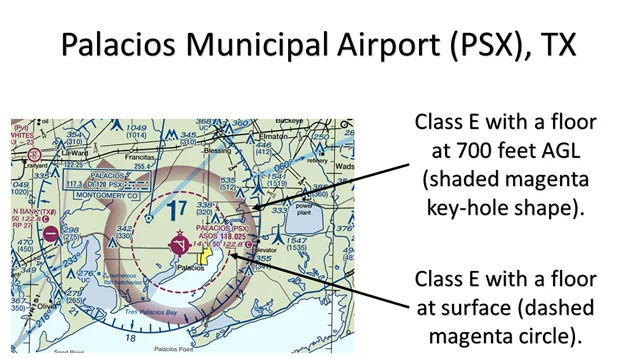
2. Class E Transition Areas (E3)
This one can begin from 700 to 1,200 feet above AGL, so it’s depicted in two ways.
| 700 feet AGL | The thick shaded magenta band represents this area, indicating that Class E Airspace starts at 700 feet AGL around near-towered airports. |
| 1,200 feet AGL | The thick shaded blue band represents this area, indicating that Class E Airspace starts at this altitude in areas away from airports. |
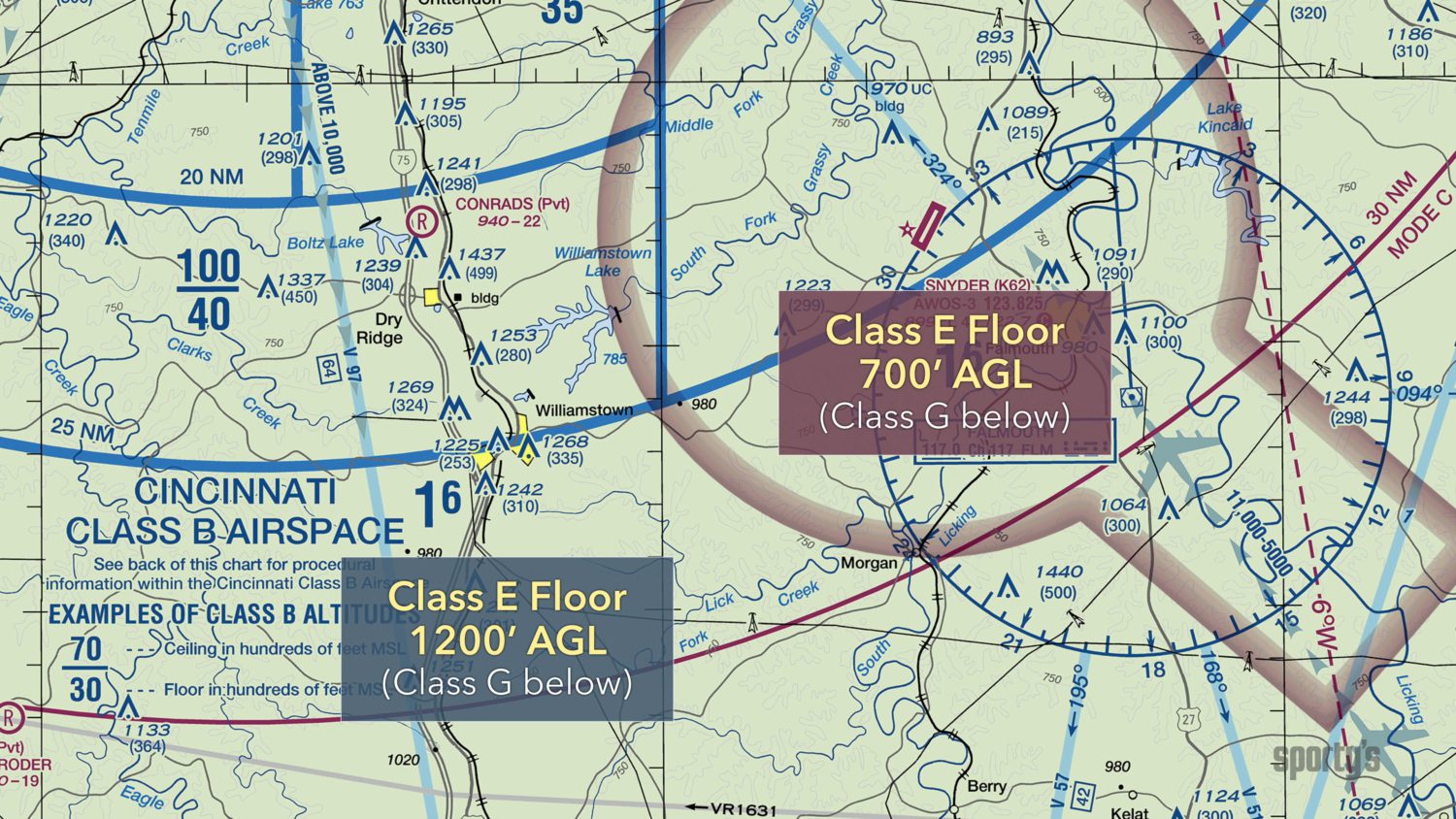
3. Class E En route Airspace and Airspaces Above FL 600
No specific boundaries are used, as it often extends across wide airways and has no marked limits.
Class E Airspace Requirements for Drone Pilots
According to the FAA, Class E Airspace drone pilots must follow weather and visibility requirements to ensure safe flying operations.
1. Class E Airspace Visibility Requirements and Weather Minimums
| Altitude | Visibility | Cloud Clearance |
| Below 10,000 feet MSL | 3 statute miles | Must remain 500 feet below, 1,000 feet above, and 2,000 feet horizontally from clouds. |
| At or Above 10,000 feet MSL | 5 statute miles | Must remain 1,000 feet below, 1,000 feet above, and 1 statute mile horizontally from clouds. |
2. Drone Flying Authorization Requirements for Class E Airspace
In controlled Class E Airspace near airports, drone pilots may need prior flying authorization through the LAANC (Low Altitude Authorization and Notification Capability).
The following are the requirements:
1. For Class E starting at 700 or 1,200 feet AGL, no prior authorization is required for drone operations.
2. For surface Class E Airspace (E2), you must obtain prior authorization from Air Traffic Control (ATC) before operating within this airspace.
3. For Class En Route and transition areas (including E3 and E4), you don’t need prior authorization because they are long distances or used only for high-altitude aircraft.
4. Night operations in Class E airspace: Drone pilots must follow additional requirements for night operations, including:
– Aircraft must be equipped with anti-collision lighting visible for 3 statute miles
– Pilots must complete additional night operations training under Part 107
– All other Class E weather minimums still apply
Note: Most drone operations occur below Class E airspace in many areas, as the typical 400-foot AGL ceiling for drone operations often places them in Class G (uncontrolled) airspace.
Conclusion
Class E Airspace might seem complex initially, especially when it comes to understanding its boundaries and requirements.
However, with the guidance in this comprehensive guide, you can handle every nuance of flying drones in Class E with confidence.
Interested in learning more about airspaces, FAA regulations, and essential piloting skills to ensure safety while flying near controlled paths?
Check our drone pilot training programs here.
FAQs
1. Do I need authorization to fly in all types of Class E Airspace?
No, you don’t need authorization to fly drones in all types of Class E Airspaces.
Just the surface Class E2 airspace with towered airports usually requires authorization from ATC because this airspace serves active airport operations.
2. What should I do if I need to fly in Class E Airspace near an airport?
If you want to fly a drone in a Class E Airspace type near airports, you must first verify the type of Class E Airspace you are in—use FAA’s B4UFLY app or Airmap to understand the exact authorization requirements.
Once confirmed that authorization is required in a specific area, you can quickly obtain approval for the LAANC-enabled areas by applying online.
If the area is not LAAN enabled, visit the FAA’s Drone Zone to register and apply for airspace authorization.
3. What is the floor of Class E Airspace when designated in conjunction with an airway?
When Class E Airspace is designated in conjunction with an airway, the floor will typically start at 1,200 feet AGL.
However, in some populated or complex airspaces, the floor of Class E Airspace may begin at 700 feet AGL. This lower floor allows safe transitions when flying nearby airports.







Add Your Comment